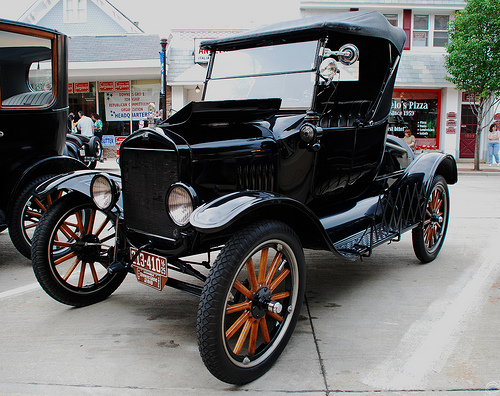
« PREVIOUS ENTRY
“How did you find my site?” and Vannevar Bush’s memex

It’s hard to hack cars these days. Open up the hood: The guts of an automobile have become an inscrutably tightly-packed puzzle of precision-engineered pieces and patented software. The panels are, by design, essentially unrepairable; when damaged, they’re built to be pulled off and replaced wholesale.
Granted, there are still folks hotrodding and hacking cars, and just today Ford announced that it would soon allow geeks to put Bug Labs open-source hardware modules in their cars. But if you want to get a sense of how un-DIY the car has become, check out this New Yorker piece from 1936 — “Farewell, My Lovely” — in which E. B. White, in hilarious and gorgeous prose, memorializes the Model T. It turns out that pretty much everyone was modding the heck out of their cars, pretty much as soon as they drove them off the lot:
There was this about a Model T; the purchaser never regarded his purchase as a complete, finished product. When you bought a Ford, you figured you had a start — a vibrant, spirited framework to which could be screwed an almost limitless assortment of decorative and functional hardware. Driving away from the agency, hugging the new wheel between your knees, you were already full of creative worry. A Ford was born naked as a baby, and a flourishing industry grew up out of correcting its rare deficiencies and combating its fascinating diseases. Those were the great days of lily-painting. I have been looking at some old Sears Roebuck catalogues, and they bring everything back so clear.
First you bought a Ruby Safety Reflector for the rear, so that your posterior would glow in another car’s brilliance. Then you invested thirty-nine cents in some radiator Moto Wings, a popular ornament which gave the Pegasus touch to the machine and did something godlike to the owner. For nine cents you bought a fan-belt guide to keep the belt from slipping off the pulley. You bought a radiator compound to stop leaks. This was as much a part of everybody’s equipment as aspirin tablets are of a medicine cabinet. You bought special oil to stop chattering, a clamp-on dash light, a patching outfit, a tool box which you bolted on the running board, a sun visor, a steering-column brace to keep the column rigid, and a set of emergency containers for gas, oil and water - three thin, disc-like cans which reposed in a case on the running board during long, important journeys - red for gas, gray for water, green for oil. It was only a beginning. After the car was about a year old, steps were taken to check the alarming disintegration. (Model T was full of tumors, but they were benign.) A set of anti-rattlers (ninety-eight cents) was a popular panacea. You hooked them on to the gas and spark rods, to the brake pull rod, and to the steering-rod connections. Hood silencers, of black rubber, were applied to the fluttering hood. Shock absorbers and snubbers gave ‘complete relaxation’. Some people bought rubber pedal pads, to fit over the standard metal pedals. (I didn’t like these, I remember.) Persons of a suspicious or pugnacious turn of mind bought a rear-view mirror; but most Model T owners weren’t worried by what was coming from behind because they would soon enough see it out in front. They rode in a state of cheerful catalepsy.
(This is a seriously delightful piece of writing. Print it up or splort it into Instapaper or something, and save it for later this evening. You’ll be glad you did.)
But back to hacking. Obviously, there are good reasons cars aren’t hackable these days. Society and the marketplace has demanded they be much safer, so they’re much more tightly regulated and meticulously engineered. (Those unreplaceable panels are both a feature and bug: Sure, you can’t bang them back into shape and reattach them … but in the process of being crushed, they absorbed so much energy they probably saved your life.) But I can’t help but think that if cars hadn’t become such sealed black boxes — if their owners still tinkered with them as much as Model T owners did — then we might have seen many more cool experiments in hacking them for ultra-high mileage.
(That picture above from Chad Horwedel’s Creative-Commons-licensed Flickr stream!)
I'm Clive Thompson, the author of Smarter Than You Think: How Technology is Changing Our Minds for the Better (Penguin Press). You can order the book now at Amazon, Barnes and Noble, Powells, Indiebound, or through your local bookstore! I'm also a contributing writer for the New York Times Magazine and a columnist for Wired magazine. Email is here or ping me via the antiquated form of AOL IM (pomeranian99).

ECHO
Erik Weissengruber
Vespaboy
Terri Senft
Tom Igoe
El Rey Del Art
Morgan Noel
Maura Johnston
Cori Eckert
Heather Gold
Andrew Hearst
Chris Allbritton
Bret Dawson
Michele Tepper
Sharyn November
Gail Jaitin
Barnaby Marshall
Frankly, I'd Rather Not
The Shifted Librarian
Ryan Bigge
Nick Denton
Howard Sherman's Nuggets
Serial Deviant
Ellen McDermott
Jeff Liu
Marc Kelsey
Chris Shieh
Iron Monkey
Diversions
Rob Toole
Donut Rock City
Ross Judson
Idle Words
J-Walk Blog
The Antic Muse
Tribblescape
Little Things
Jeff Heer
Abstract Dynamics
Snark Market
Plastic Bag
Sensory Impact
Incoming Signals
MemeFirst
MemoryCard
Majikthise
Ludonauts
Boing Boing
Slashdot
Atrios
Smart Mobs
Plastic
Ludology.org
The Feature
Gizmodo
game girl
Mindjack
Techdirt Wireless News
Corante Gaming blog
Corante Social Software blog
ECHO
SciTech Daily
Arts and Letters Daily
Textually.org
BlogPulse
Robots.net
Alan Reiter's Wireless Data Weblog
Brad DeLong
Viral Marketing Blog
Gameblogs
Slashdot Games